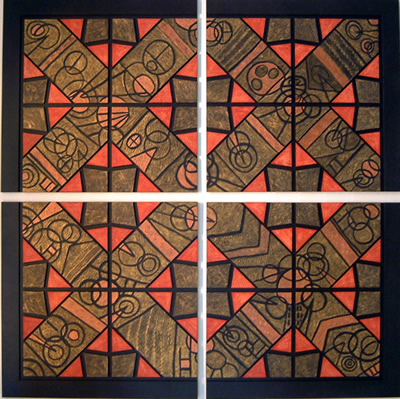
Symbolic Landscape, gouache on wood 240 x 240cm 2002
|
The artwork consists of Aboriginal
petroglyphs that were carved on the rock formations, most
of the particular areas are around the North West and north
eastern coastline of Tasmania. The significance of my paintings
is to achieve with the use of wood, impasto gel, modelling
compound and gouache paint, a portrayal of spiritualism, symbolism
and mythology in Aboriginal culture in Tasmania. Using Aboriginal
symbols from the past as a perspective into the future. The
work will demonstrate a contemporary form of art from an Aboriginal’s
perspective, yet recognising the European context of much
of its production. Done in geometrical shapes and structure
as a form of depicting the Aboriginal people existing in a
geometrically constructed and contemporary world.
|
|
My mother, Rose Australia Thomas, died
when I was two years old. My motherís mother, Augusta Lavinia
Maynard, reared me from an early age in Launceston, along with
eleven children and four grandchildren. For a long time, I was
cut off from my Aboriginal past.
I began painting with Sandra Walters and
then with the late Greg Waddle for 18 months before going to the
University of Tasmania. At the moment Iím fulfilling a dream and
starting my Master of Fine Arts and Design degree at the
University of Tasmania, Launceston. I live out under the Great
Western Tiers, in the small township of Bishopsbourne, a
painterís paradise.
The significance of my project for my
painting is to achieve, with the use of wood, impasto gel,
modelling compound and gouache, a landscape portraying
symbolism, spirituality, and mythology within the Tasmanian
aboriginal culture. To achieve this, designs of Tasmanian
Aboriginal petroglyphs were formed in the texture of modelling
compound and impasto gel to create a sense of Aboriginal
presence on the island of Tasmania being a haven for my people.
The purpose of the painting, using the Tasmanian Aboriginal
petroglyphs, is my way of recording and protecting historical
information about Aboriginal ancestral beings decaying or
wearing away in time from the natural elements. Using shapes and
structures within the work I depict the geometrically
constructed contemporary world in which Aboriginal are forced to
live under the dominance of white Europeans. Outlines of the
Tasmanian Aboriginal petroglyphs are believed to be a form of
Aboriginal documentation used to educate their youth thousands
of years ago. The framing isolated the work within the
constraints of a barrier. Names of Aboriginal people have been
inscribed backwards on the two frames, thus connecting them to
the past and protecting the petroglyphs for the future. Gold is
used to show the wealth of our land and ochre used as a form of
decoration references Manalargenna, Chief of Cape Portland tribe
from whom I originated. From the times of Manalargenna to a
contemporary world of today Tasmania is a safe haven for all my
people. Aboriginals who dwell on the Bass Strait islands, are
there because thatís where Manalargenna and our ancestors were
exiled, and he longed to be on the Cape PortlandóBen Lomond land
and although I have seen all of Australia, I see Tasmania as my
refuge, my haven.
Judith-Rose Thomas thanks Manalargenna
for her Aboriginal heritage, Aunty Molly for her encouragement
throughout the time I spent at the University of Tasmania, and
Sandra Walters for beginning my life of art.
Judith-Rose Thomas 2002
|
